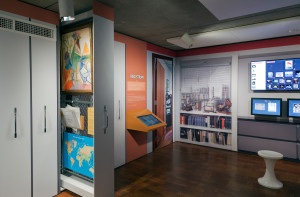For additional resources, see the Kohl’s Art Generation Online Lab & Gallery guide.
Did you know that works of art are world travelers? Pieces in the Museum’s Collection have been everywhere from California to Japan, to England and back! Registrar staff track every single piece in the Collection, make sure the works are kept safe when traveling, and maintain all the information we have about the works of art.
↓ What does a registrar do?
↓ Art Installation
↓ Art De-Installation

Part of the job of a registrar is to keep records on each work of art in the Museum’s Collection. Each work has its own object file, which is like your permanent record at school. However, where your school record likely contains report cards and teacher comments, an artwork’s object file includes all the information on how the work of art came to the Museum, where it has been, and any other information that is known about the piece. Read on to find out what kinds of things are included in an object file.
Object Card
This card keeps track of all the basic information about the artwork (the artist, the media used, etc.). The Museum now uses an online computer-based database instead of object cards, but the original paper cards are kept in the object file for reference.
TMS Record
This is the online, computer-based file on an artwork—it’s the twenty-first-century version of an object card. It shows all the important basic information about the artwork, as well as its exhibition history—that is, where it has traveled.
Invoice
An invoice is like a receipt you get at a store: it shows that you bought something and that you now own it. It is important that the Museum knows exactly how and when a work of art came to be in the Collection, so invoices like this one are always saved. It also provides the registrars with information on an artwork’s provenance, or the history of who owned it.
You, too, can know how and when any artwork came into the Museum’s Collection. This information can be found on the labels that you see alongside an artwork in the galleries. The last line on the label, called the credit line, credits (or identifies) how the work was acquired (e.g., gift, purchase). After that, there is an accession number, which is the artwork’s own unique ID. The first four numbers of the accession number indicate the year the work was acquired.
Labels from Back of Painting
In the past, special labels were added to the backside of an artwork each time it traveled on loan to another museum. When those labels fall off or are removed by conservators, they are kept in the object file to show the history of the object’s travel.
Condition Report
Conservators, who make sure works of art are in the best shape possible, complete condition reports, noting, in detail, how every piece and part of the work looks. These reports are almost like lab reports you might do in school! They are used by curators, registrars, and conservators to see if anything has changed in the condition (appearance) of the artwork over time.
Condition Report Photographs
Object files usually include detail photographs to help document the condition reports done by conservators.
Condition Report from Other Museums
When a work of art travels, conservators at the museum to which it travels create their own condition report to show that they are sending the painting back in the same condition they received it.
Postcard
Museums often create postcards, notecards, journals, and other merchandise for their exhibitions. When one of these items includes a picture of a Museum artwork, which is on loan for the exhibition, an example is kept in the object file.
News Article
Object files hold important news articles relating directly to the work of art.
Research and Reproduction Photograph
When curators or other scholars study a work of art, their research is kept in the object file. A reproduction, or photograph of the piece, often accompanies the research. These photographs are kept in case the condition of the artwork changes, so the Museum knows what it used to look like.
Rights and Reproduction Acknowledgment
Artwork can end up in many different places—even a 5th grade reading textbook! When an author or a publisher wants to put an image of an artwork in a book or on a website, the Museum creates an agreement with them to make sure that the image is not used in an inappropriate way.

